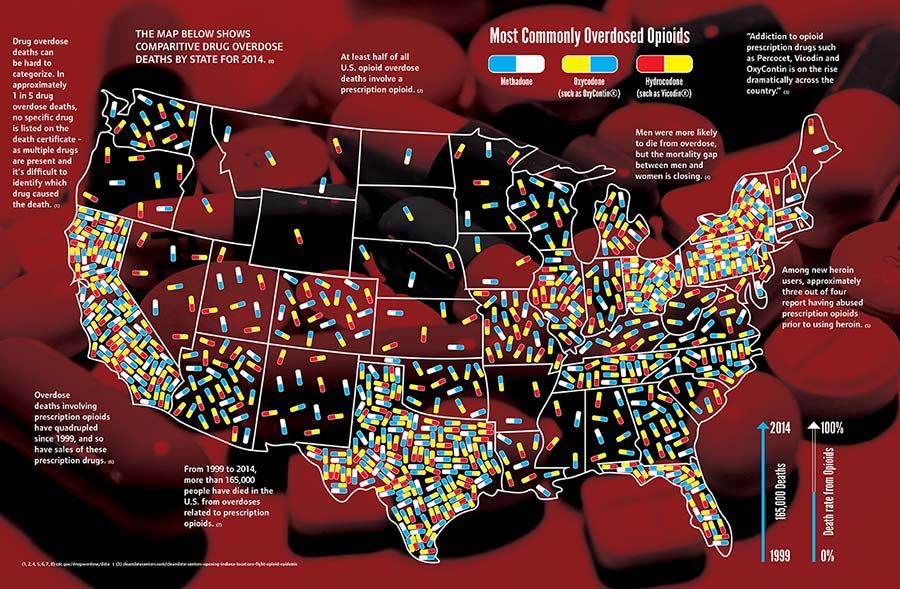Terrorists move over. There’s a far worse terror in town that is indiscriminately targeting kids and adults, killing well over 10 times more Americans a year than all terrorist attacks of the last 16 years combined.
That’s correct. While politicians have spent several trillion dollars on foreign wars, they’ve distracted us from the very real threat that can be found in our own homes, targeting our families. In 1997, the United States became one of only two developed countries on the planet that made it legal for pharmaceutical companies to advertise drugs directly to consumers, including children. Since then prescription drug addiction and prescription drug overdoses have skyrocketed – in fact, quadrupled.
We now have a generation of young adults who grew up with a drug dealer living in their homes 24/7 – the television, magazines and internet pushing pills as a solution to every imaginable condition. Eighty percent of opioid addictions begin with a prescription for pain medication at your doctor’s office. It must be safe if a doctor prescribes it, right? According to the Centers for Disease Control and Prevention, in 2014 47,055 people died of an accidental drug overdose – 29,467 of those from opioid-related drugs, which includes prescription pain medication. To put that into perspective, firearms were used to kill 13,286 people in the United States over the same period (excluding suicide) with a total of 3,340 killed in terrorist attacks on American soil since 1995 (3,003 in the September 2001 attacks alone).
Drug overdose is now the leading cause of accidental death in the United States. Four out of five people who become addicted to heroin start out with a legal prescription from a physician – a result of injury, post-operative care or a medical procedure. Substance-abuse disorders affect 20.8 million people in the United States — as many as those with diabetes and 1½ times as many as those with cancer. Yet, only one in 10 people receives treatment.
It’s an epidemic that the CEO of CleanSlate, Gregory Marotta, says has crossed all socioeconomic boundaries. Forget about lecturing your kids on the dangers of drugs, white middle-class women are actually at higher risk. “It’s no longer considered a disease associated with race, religion or class,” he explains. “It’s indiscriminate, right across the board.”

It’s a sobering viewpoint that his colleague, Kelly Clark, the Chief Medical Officer of CleanSlate supports: “Drug addiction has always been viewed as something shameful, something to be hidden away from friends, employees and parents, but it’s actually not a moral failing,” she explains.
What if addiction was seen as just another chronic disease, alongside asthma or diabetes? Would this change your opinion of the almost 36 million people worldwide who are addicted to prescription opioid drugs? These are ordinary people who started on painkillers, prescribed by a doctor to relieve a medical problem, without realizing the risk of it turning into something deadly – addiction. We don’t talk about a diabetic being clean, or a diabetic being sober. Like other chronic illnesses, addiction is a disease that needs to be managed. “We’ve always had a tendency to create stigmas around brain diseases,” explains Clark. “Whether it’s epilepsy or mental illness, we’ve historically thought that people with these conditions were cursed or possessed, or somehow to be made fun of.
Most cultures have branded addiction as an issue of willpower. Society views those that take drugs as weak and unproductive, but ignoring this problem and banishing millions of people to the fringes of society is not working. Our modern healthcare networks, with clinics, hospitals, and insurance schemes, were established decades ago to service the sick and dying, yet addiction treatment was somehow sidelined – with blame, guilt and shame replacing proper care. When last did you write off a relative for being in the hospital for high blood pressure or a heart condition?
Clark thinks about 50 percent of addictive diseases are genetic, but surprisingly, we already have opioids in our brain – endorphins – our body’s natural painkiller and feel-good chemical. Pills and opiates created in labs, or broken down from poppy seeds, contain levels of opiates our brains were not designed to handle.
Morphine makes most people sleepy, but some will experience an energy rush that makes them want to clean the garage. This type of person is a high addiction risk and shouldn’t be given opioids. Extended use will actually change your brain and it won’t change back if you stop.







